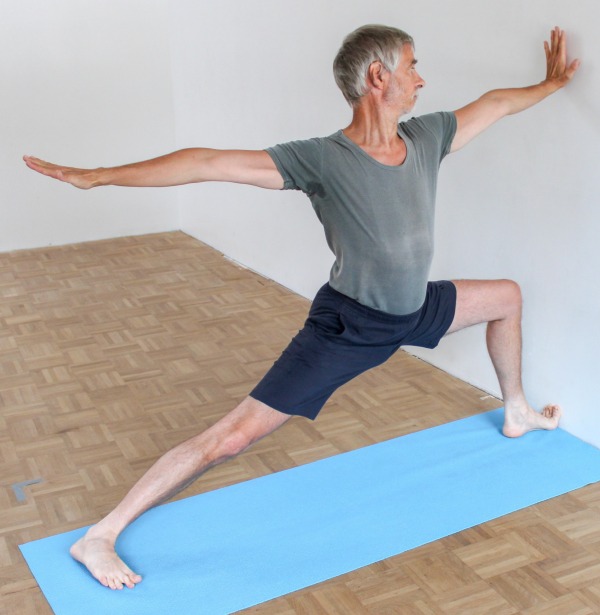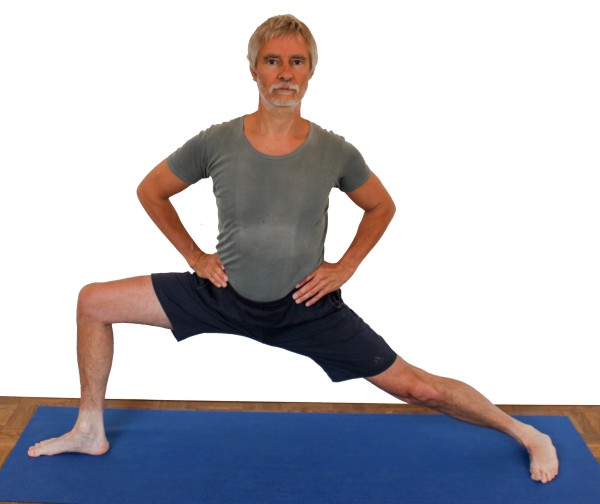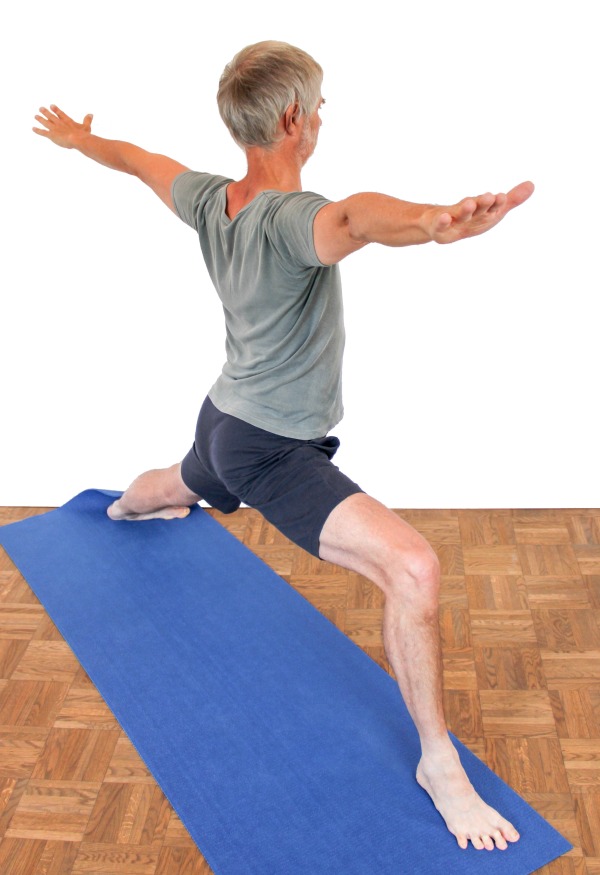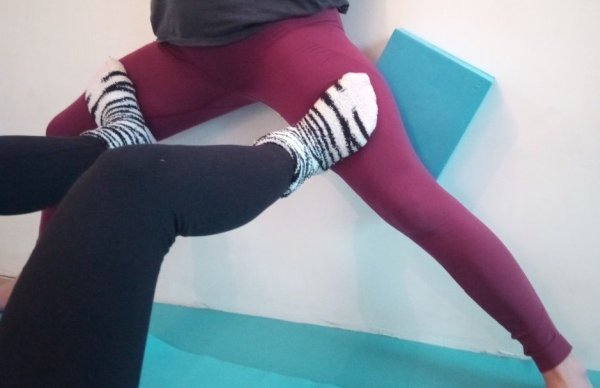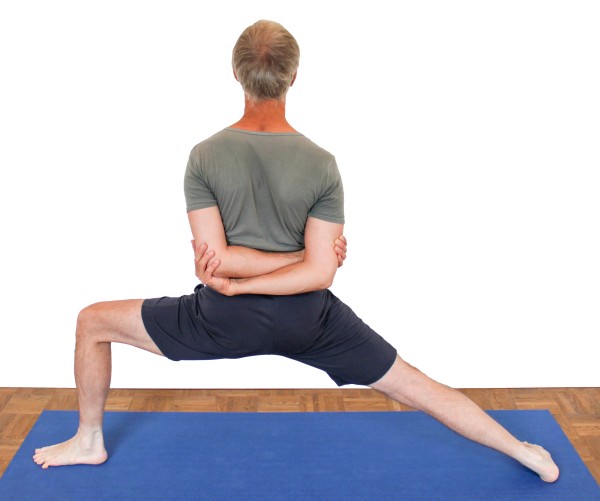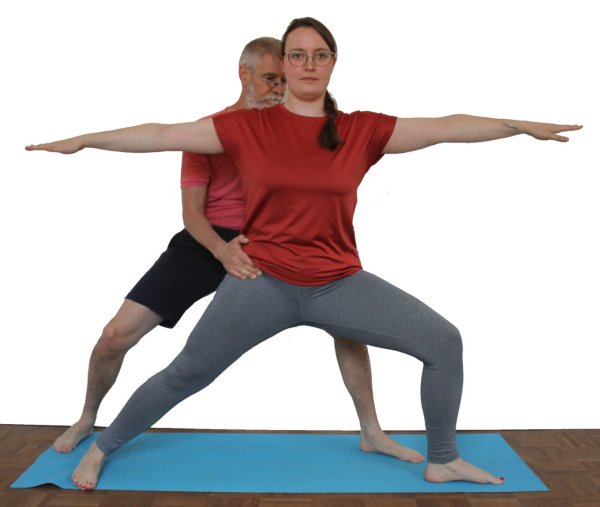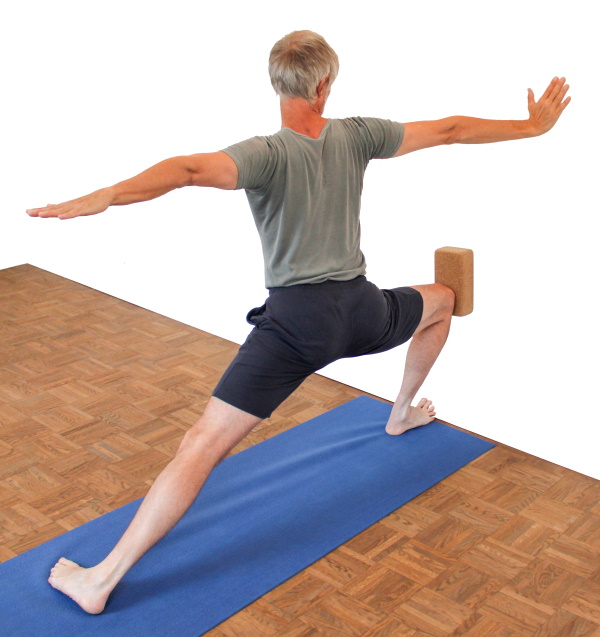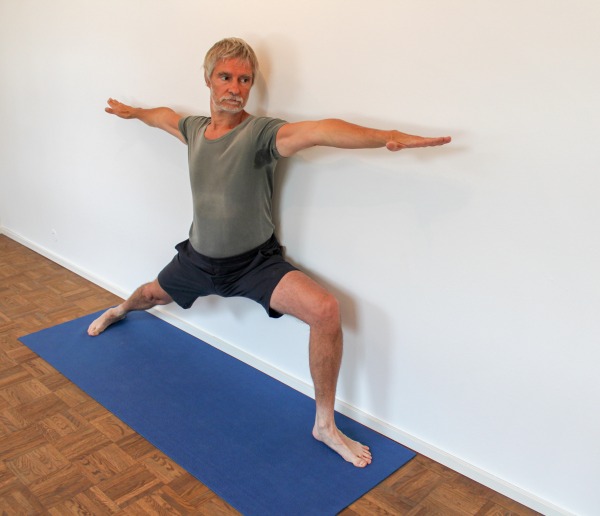- stand in
tadasana. Put your hands together in front of your chest such that the fingertips touch each other
and your elbows move apart, so that your arms are almost horizontal.
- Jump with your feet a little more than one own leg length apart and stretch your arms apart.
Taking the straddle can be done without jumping.
- from parallel middle lines of the feet turn the left leg about 20° inwards,
the entire right leg (from the hip) 90°. Hold the pelvis in the (virtual)
plane both legs span or - as far as possible - bring it back there
- make sure that you stand well on both feet with equal pressure distribution on the
parts of the sole of the foot (even between the heel and the 5 balls
of the foot and among the 5 balls of the foot).
- stretch the left leg completely
- pull it backward to the maximum
- exorotate the left leg (unless otherwise indicated) to the maximum
Press the left outer foot onto the floor. Erect the pelvis to the vertical
- bend the right leg at a moderate speed so that the pelvis remains upright and does not tilt forward.
On the left side the pelvis should not move further to the front than on the right,
nor should it stand higher on the left side than on the right
- Stretch your upper body vertically from the pelvis upwards and your arms horizontally to the side, the shoulder blades are down (in depression).
|
- because the hip joints are three-dimensionally movable, here usually you find a combination of three evasive movements in the pelvis:
- the left hip moves forward
- the left hip moves up
- the pelvis tilts forward, so the buttocks come up and the hip bones tilt down
To avoid or at least reduce this combined evasive movement:
- push the feet away from each other with force, this becomes all the more possible the more the right thigh approaches the horizontal.
This works a bit against 1) and 2)
- turn out the left thigh to the maximum. press the left outer foot down as hard
as the inner foot. The exorotation eases pressing down the left outer foot and vice versa.
Both promote the uplifting of the pelvis. These three factors are related and ease the
straightening of the upper body as well as keeping it upright. These movements only
find their limit where the left inner foot starts to lift off or the outer ankle
area feels like being overstretched.
However, a more or less pronounced sensation of stretching in the
muscles of the outer lower leg is physiological in this posture.
This detail also works against 1) and 2) too
- use a lot of the butt muscles' strength to raise the pelvis. Effective against 3)
- measure the distance of the feet from each other in such a way that, when the right thigh is horizontal,
the right knee stands over the right heel (the lower leg is vertical).
Due to the lack of strength of the quadriceps of the bent leg or flexibility of the
adductors (esp. of the stretched leg) not everyone can bend the knee that far,
therefore a smaller distance may be advisable in some cases, because too large distances destroy the muscular work to a large extent. The
quadriceps should work:
- that the pelvis does not sink down
- to push the feet away from each other
Since the above mentioned flexibility of the
adductors
in fact limits the angle between the two legs (or between pelvis and bent or stretched leg)
and not the bending of the knee itself, the distance can be chosen slightly smaller for maximum muscular activity,
so that with the maximum bearable stretching sensation of the
adductors the knee stands just above the heel
(instead of with flat thigh).
Note: if the distance between the feet is too big, the feeling for the ability to push the feet
away from each other also gets lost.
- when trying to keep the pelvis in the plane of the legs (i. e. the left hip is at the same
amount backward as the right hip) the right knee will inevitably come forward a little bit, at least as long as you don't reach
samakonasana (Lateral split) - and even then, most of the time it does.
Do not completely prevent the knee from evading forward if the pelvis would otherwise
become slanted. Straightness of the pelvis is the more important topic.
The knee of the bent leg that evades inwards/forwards also moves slightly downwards in an arc.
These movements tend to put strain on the inner knee, but this is rarely associated
with subjectively felt strain if the associated butt muscles pull the leg back as much as possible.
Objectively, this reduces the forces that can cause pain in the inner knee.
In the rare case that pain nevertheless occurs in the inner knee,
the pelvis can be allowed a little evasive movement in the horizontal
plane towards the bent leg and above all the position of the foot can be adapted
to the angle of the thigh of the bent leg, i.e. the requirement is waived that
the foot with its midline be parallel to the pelvis and to the
long edge of the mat and therefore be pointing to the opposite heel.
- turn the right leg out also, even if this is only marginally possible; this makes it easier
to move the right knee backwards and protects the inner knee, in which otherwise unpleasant pressure could occur.
- push the feet apart against the friction of the floor without lifting the pelvis, which usually would be the case.
This movement represents a more complete work of the
Quadrizeps in the bent leg and is essential for correcting the position of the pelvis. Leave the right heel as heavy
as the right ball of the foot, so especially do not lift it off. The frequently observed lifting of
the heel is a consequence of the tendency to relieve the thigh by increasing the use of
calf muscles and leads to a decrease in pushing the feet apart, as a result, the position of the pelvis may deteriorate.
In that case, the force exerted in the knee on the completely placed foot to
turn out the lower leg is also missing. This is a work of the biceps of the leg,
and it slightly supports the movement of the knee backwards.
- Use the power of the butt muscles in two ways:
- right butt muscles: to move the right knee further backward, keeping the pelvis in the plane of the legs
- both sides: to align the pelvis in the sense of not tilting it forward
- It is well known that maximum lateral abduction in the hip joint is a function of exorotation in the sense that
it is possible to move the leg outwards into the abduction the further it is turned out.
An exorotation of the leg from neutral zero can improve the range of possible
lateral abduction by more than 90° in persons with a well-mobile ischiocrural group.
In the second warrior pose, this causes the inclination of the pelvis to tilt in the frontal plane to the side
of the bent leg, since lateral abduction - depending on the distance of the feet and the degree
of bending of the bent knee - is very limited, also due to the endorotated position
of the stretched leg. Note: the stretched leg IS in endorotated position, but MAKES an exorotation movement.
Furthermore, the very limited lateral abduction ability without exorotation causes the
inclination of the foot of the stretched leg to turn out compared to the
initial 20° turned in position resp. that of the entire thigh to turn out in the hip joint.
- for people with shortened
hip flexors (m. iliopsoas) as well as with shortened adductors erecting the pelvis may be very heavy. Their pelvis will tilt forward the more the right knee bends.
In extreme cases, it is advisable not to bend to the horizontal of the thigh, in order to avoid
overexertion of the lower autochthonous back muscles due to heavy erection work for
the upper part of the body in a hyperlordosed lumbar spine, but to focus on raising the pelvis.
- The arms should be horizontal. But to do so, lift your arms less than to move them apart,
i.e. away from the spine.
This has the advantage that, firstly, the lateral clearance in the shoulder allows for active relaxation of the
trapezius, on the other hand, the mere raising of the arms sometimes leads to the arm being moved towards the body,
which increases causes the cramping tendency of the
trapezius
- Stretch your arms and hands to your fingertips. In order to do so:
- stretch the
metacarpal joints (finger base joints) and the finger joint to the point where you feel even tension in palmar and plantar side of the fingers
- do not allow your forearms to hang in the elbows, but instead create an even work in the
and
triceps through muscular activity, so that the joint gap on the back side of the elbow joint is relieved.
This activity causes visible work of the the
triceps instead of drooping asleep.
This is especially important for people with overstretching ability in the elbow joints.
- With the evasive movements of the pelvis (tilting forward, tilting sideways to the bending leg,
turning horizontally to the bending leg) the upper part of the body above the pelvis
is inevitably misaligned. It makes no sense to suppress them with all your strength,
for example by bringing the upper body into a sideways curve or back bend.
Use the necessary energy for this better on corrections of the position of the pelvis
- when the outer foot of the stretched leg comes up, this is almost always a sign
that the feet are pushed away from each other with insufficient strength or
that the stretched leg is not sufficiently turned out.
- The frequently observed tendency to bend the knee of the stretched leg reflects the
strong pull of the hip flexors., mainly of the
m. iliopsoas , when trying to errect the pelvis
Therefore, pay close attention to the complete stretching of the "stretched" leg, as
- it is essential for the statics of posture
- otherwise possibly incorrect loads in the knee cause pain
- the stretching of the
hip flexors of this side of the body in this pose depends on the stretching of the leg
- Note that the evading movements in the pelvis increase considerably as the bending knee
is bent further (in the direction of the horizontal thigh). Some occur only when the knee is bent far.
As a result, little more than indicated postures referred to bending the knee are largely ineffective
- in some cases, this pose leads to cramp in the area of the
abductors on the side of the stretching leg. This is completely harmless until further notice and
can be reduced by a quicker sequence of side changes if necessary. It can also be
helpful to have one or two inserted
trikonasana after the onset of cramping or
if a tendency to cramp shows
where the upper part of the body is lowered rather than being precisely stretched
sideways, as this results in stretching and relaxation of the
adductors
| known issues that may occur even when practicing correctly |
|
|


